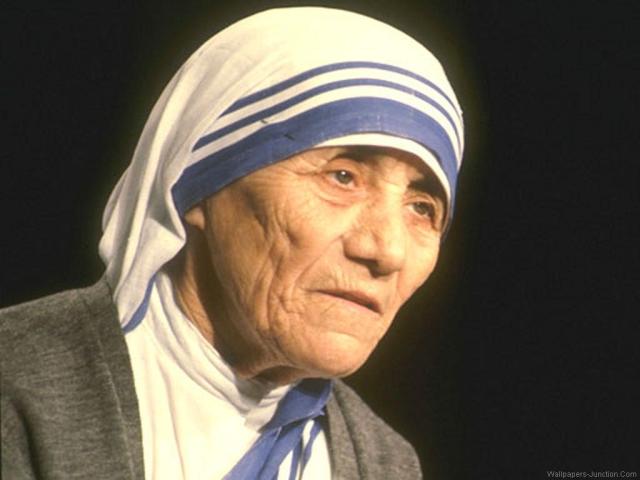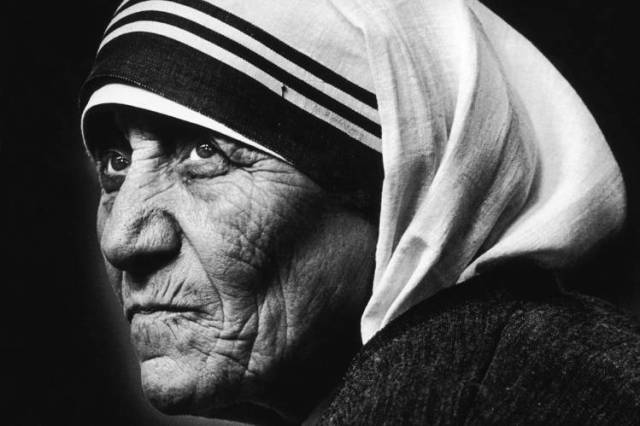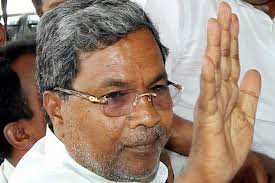The Nagpur bench of the Bombay High Court has cancelled the bail application of Delhi University lecturer G.N. Saibabaand issued a contempt of court notice to the author, Arundhati Roy for writing an article in Outlook magazine criticising the charges against him.
In my view, the court is wrong on both counts.
The case against Saibaba is that he had links with Maoist extremists. However, in Sri Indra Das vs. State of Assam, 2011. the Supreme Court observed that mere membership of a banned organisation (i.e. banned under the Unlawful Activities Prevention Act or TADA or any other statute) will not incriminate a person. The court referred to several decisions of the United States Supreme Court in this connection, which it followed.
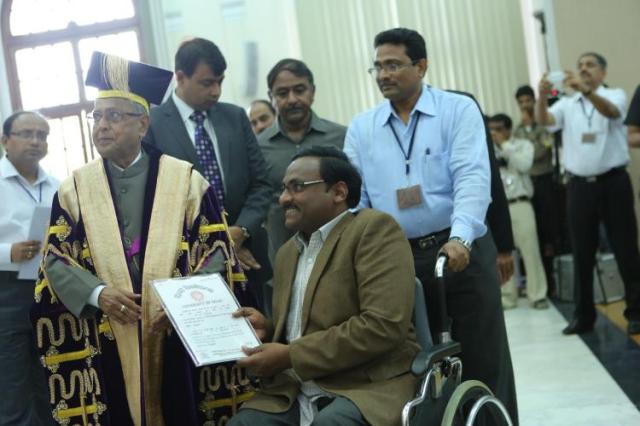
The President of India, Pranab Mukherjee, presents Saibaba with his doctoral degree at the 90th convocation of Delhi University on March 19, 2003.
In Scales v United States (1961), the US Supreme Court made a distinction between an active and a passive member of an organisation, and held that the latter could not be charged of a crime. In that decision Justice Harlan observed:
“The clause (in the McCarran Act, 1950) does not make criminal all associations with an organisation which has been shown to engage in illegal advocacy. There must be clear proof that a defendant ‘specifically intends to accomplish the aims of the organisation by resort to violence’. A person may be foolish, deluded, or perhaps merely optimistic, but he is not by this statute made a criminal.”
In Noto v United States (1961), Justice Harlan observed:
“… The mere teaching of Communist theory, including the teaching of the moral propriety or even moral necessity for a resort to force and violence, is not the same as preparing a group for violent action and steeling it to such action. There must be some substantial direct or circumstantial evidence of a call to violence now or in the future which is both sufficiently strong and sufficiently pervasive to lend colour to the otherwise ambiguous theoretical material regarding Communist Party teaching.”
Justice Hugo Black in a concurring judgment in the same case wrote:
“In 1799, the English Parliament passed a law outlawing certain named societies on the ground that they were engaged in ‘a traitorous conspiracy’ in conjunction with the persons from time to time exercising the powers of government in France.. One of the many strong arguments made by those who opposed the enactment of this law was stated by a member of that body, Mr. Tierney :
‘The remedy proposed goes to the putting an end to all these societies together. I object to the system, of which this is only a branch; for the Right Hon. gentleman has told us he intends to propose laws from time to time upon this subject, as cases may arise to require them. I say these attempts lead to consequences of the most horrible kind. I see that government are acting thus: those whom they cannot prove to be guilty, they will punish for their suspicion. To support this system, we must have a swarm of spies and informers. They are the very pillars of such a system of government.’
In Communist Party v. Subversive Activities Control Board (1961), Justice Hugo Black observed:
“The first banning of an association because it advocates hated ideas – whether that association be called a political party or not – marks a fateful moment in the history of a free country. That moment seems to have arrived for this country. This whole Act, with its pains and penalties, embarks this country, for the first time, on the dangerous adventure of outlawing groups that preach doctrines nearly all Americans detest. When the practice of outlawing parties and various public groups begins, no one can say where it will end. In most countries such a practice once begun ends with a one party government.”
In Joint Anti-Fascist Refugee Committee v. McGrath (1951), Justice Douglas in his concurring judgment observed: “In days of great tension when feelings run high, it is a temptation to take short cuts by borrowing from the totalitarian techniques of our opponents. But when we do, we set in motion a subversive influence of our own design that destroys us from within.”
In Yates v. United States (1957), Justice Harlan observed:
“In failing to distinguish between advocacy of forcible overthrow as an abstract doctrine and advocacy of action to that end, the District Court appears to have been led astray by the holding in Dennis that advocacy of violent action to be taken at some future time was enough. The District Court apparently thought that Dennis obliterated the traditional dividing line between advocacy of abstract doctrine and advocacy of action.”
In Brandenburg v. Ohio (1969), the US Supreme Court by a unanimous decision reversed its earlier decision in Whitney v. California (1927) and observed: “The Constitutional guarantees of free speech and free press do not permit a state to forbid or proscribe advocacy of the use of force or of law violation except where such advocacy is directed to inciting or producing imminent lawless action and is likely to incite or produce such action.”
In Whitney, Justice Brandeis, one of the most celebrated judges of the US Supreme Court had, in a concurring judgment which really reads like a dissent, observed:
“Fear of serious injury cannot alone justify suppression of free speech and assembly. Men feared witches and burned women. It is the function of free speech to free men from the bondage of irrational fears. To justify suppression of free speech there must be reasonable ground to fear that serious evil will result if free speech is practiced. There must be reasonable ground to believe that the danger apprehended is imminent… ….. The wide difference between advocacy and incitement, between preparation and attempt, between assembling and conspiracy, must be borne in mind.”
In the same judgment, Justice Brandeis went on to observe:
“Those who won our independence by revolution were not cowards. They did not fear political change. They did not exalt order at the cost of liberty. To courageous, self-reliant men, with confidence in the power of free and fearless reasoning applied through the processes of popular government, no danger flowing from speech can be deemed clear and present, unless the incidence of the evil apprehended is so imminent that it may befall before there is opportunity for full discussion. If there be time to expose through discussion the falsehood and fallacies, to avert the evil by the process of education, the remedy to be applied is more speech, not enforced silence.”
In Gitlow v. New York (1925) Justice Holmes (with whom Justice Brandeis joined) observed:
…”If what I think the correct test is applied, it is manifest that there was no present danger of an attempt to overthrow the government by force on the part of the admittedly small minority who shared the defendant’s views. It is said that this Manifesto was more than a theory, that it was an incitement. Every idea is an incitement. It offers itself for belief, and, if believed, it is acted on unless some other belief outweighs it, or some failure of energy stifles the movement at its birth. The only difference between the expression of an opinion and an incitement in the narrower sense is the speaker’s enthusiasm for the result. Eloquence may set fire to reason. But whatever may be thought of the redundant discourse before us, it had no chance of starting a present conflagration. If, in the long run, the beliefs expressed in proletarian dictatorship are destined to be accepted by the dominant forces of the community, the only meaning of free speech is that they should be given their chance and have their way.
“If the publication of this document had been laid as an attempt to induce an uprising against government at once, and not at some indefinite time in the future, it would have presented a different question. The object would have been one with which the law might deal, subject to the doubt whether there was any danger that the publication could produce any result; or, in other words, whether it was not futile and too remote from possible consequences. But the indictment alleges the publication and nothing more.”
In Terminiello v. Chicago (1949) Justice Douglas, speaking for the majority, observed:
“….A function of free speech under our system of government is to invite dispute. It may indeed best serve its high purpose when it induces a condition of unrest, creates dissatisfaction with conditions as they are, or even stirs people to anger. Speech is often provocative and challenging. It may strike at prejudices and preconceptions and have profound unsettling effects as it presses for acceptance of an idea. That is why freedom of speech, though not absolute,…is nevertheless protected against censorship or punishment, unless shown likely to produce a clear and present danger of a serious substantive evil that rises far above public inconvenience, annoyance or unrest….There is no room under our Constitution for a more restrictive view. For the alternative would lead to standardisation of ideas either by legislatures, courts, or dominant political or community groups.”
In DeJonge v. Oregon (1937) Chief Justice Hughes wrote that the state could not punish a person making a lawful speech simply because the speech was sponsored by a subversive organisation. In Abrams v. US (1919) Justice Holmes in his dissenting judgment wrote:
“Persecution for the expression of opinions seems to me perfectly logical. If you have no doubt of your premises or your power and want a certain result with all your heart you naturally express your wishes in law and sweep away all opposition. To allow opposition by speech seems to indicate that you think the speech impotent, as when a man says that he has squared the circle, or that you do not care whole-heartedly for the result, or that you doubt either your power or your premises. But when men have realized that time has upset many fighting faiths, they may come to believe even more then they believe the very foundations of their own conduct that the ultimate good desired is better reached by free trade in ideas, — that the best test of truth is the power of the thought to get itself accepted in the competition of the market; and that truth is the only ground upon which their wishes safely can be carried out. That, at any rate, is the theory of our Constitution. It is an experiment, as all life is an experiment. Every year, if not every day, we have to wager our salvation upon some prophecy based upon imperfect knowledge. While that experiment is part of our system I think that we should be eternally vigilant against attempts to check the expression of opinions that we loathe and believe to be fraught with death, unless they so imminently threaten immediate interference with the lawful and pressing purposes of the law that an immediate check is required to save the country. I wholly disagree with the argument of the government that the 1st Amendment left the common law as to seditious libel in force. History seems to me against the notion.”
Considering the above legal position, one fails to understand how a person who is 90% disabled, is permanently confined to a wheelchair, and was held in jail for 17 months in horrible conditions could be incriminated and charged as being an imminent threat to state security, and denied bail.
The case against Arundhati Roy
I have carefully perused the article of Arundhati Roy and I fail to see how it could be regarded as contempt of court in a democratic country and with a Constitution having freedom of speech as a guaranteed right vide Article 19(1)(a).
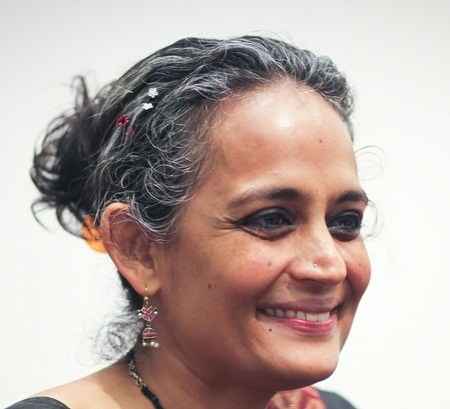
The basic principle in a democracy is that the people are supreme. It follows that all authorities – whether judges, legislators, ministers, or bureaucrats are servants of the people. Once this concept of popular sovereignty is kept firmly in mind, it becomes obvious that the people of India are the masters and all authorities (including the courts) are their servants. It would logically follow that in a democracy the people have the right to criticise judges. Why then should there be a Contempt of Courts Act, which to some extent prevents people from criticising judges or doing other things that are regarded as contempt of court?
In a democracy, the purpose of the contempt power can only be to enable the court to function. The power is not to prevent the master (the people) from criticising the servant (the judge) if the latter does not function properly or commits misconduct.
Article 19(1)(a) of the Constitution gives the right of freedom of speech and expression to all citizens. But Articles 129 and 215 give the power of contempt of court to the higher judiciary, and this power limits the freedom granted by Article 19(1)(a). How are these two provisions to be reconciled?
Once it is accepted that India is a democracy and that the people are supreme, reconciliation can only be effected by treating the right of the citizens to free speech and expression under Article 19(1)(a) to be primary, and the power of contempt to be subordinate. In other words, the people are free and have the right to criticise judges, but they should not go to the extent of making the functioning of the judiciary impossible or extremely difficult.
Hence, the true test to determine whether an act amounts to contempt of court or not is this: does it make the functioning of the judges impossible or extremely difficult? If it does not, then it does not amount to contempt of court even if it is harsh criticism
The view expressed above is, in fact, accepted now in England, the country from which India got its contempt law.
“Justice is not a cloistered virtue,” said Lord Atkin. “It must suffer the scrutiny and outspoken comments of ordinary men.”
As observed by Lord Salmon in AG vs. BBC (1981): “The description ‘Contempt of Court’ no doubt has a historical basis, but it is nonetheless misleading. Its object is not to protect the dignity of the courts but to protect the administration of justice.”
In R vs. Commissioner of Police (1968) Lord Denning observed: “Let me say at once that we will never use this jurisdiction as a means to uphold our own dignity. That must rest on surer foundations. Nor will we use it to suppress those who speak against us. We do not fear criticism, nor do we resent it. For there is something far more important at stake. It is no less than freedom of speech itself.”
Once a British newspaper ran a banner headline calling the majority judges of the House of Lords who decided the Spycatcher case (Attorney General vs. Guardian Newspaper (1987)) “YOU FOOLS”. Fali Nariman, who was present in England at that time, asked Lord Templeman, who was one of the majority, why the judges did not take contempt action. Lord Templeman smiled and said that judges in England took no notice of personal insults. Although he did not regard himself as a fool, others were entitled to their opinion.
In Balogh vs Crown Court at St Albans (1975), the defendant told the judge “You are a humourless automaton. Why don’t you self destruct?”. The judge smiled, but took no action.
The true test of contempt
The best shield and armour of a judge is his reputation of integrity, impartiality, and learning. An upright judge will hardly ever need to use the contempt power in his judicial career. I submit that the purpose of the contempt power is not to vindicate or uphold the majesty and dignity of the court (for it is automatically vindicated and upheld by the proper conduct of the judge, not by threats of using the contempt power) but only to enable the court to function. The contempt power should only be used in a rare and exceptional situation where, without using it, it becomes impossible or extremely difficult for the court to function. Even in such situations, the contempt power should not be used if a mere threat to use it suffices.
There may, of course, be differences of opinion about what acts prevent, or make very difficult, the functioning of a judge. For instance, do comments by the public (including lawyers, journalists, etc.), or publicity in the media about a pending case cause this? I think not. A judge should have the equanimity and inner strength to remain unperturbed and unruffled in any situation.
The expression ‘preventing or making it extremely difficult for the judge to function’ should ordinarily be understood with reference to a judge who has a true judge’s temperament – one that is detached, calm, with equanimity, and with broad enough shoulders to shrug off baseless criticism or attempts to influence him without being perturbed.
Contempt jurisdiction is now very sparingly exercised in these Western countries. Thus in Secretary of State for Defence v. Guardian Newspapers (1985), Lord Diplock observed that “the species of contempt which consists of ‘scandalising the judges’ is virtually obsolescent in England and may be ignored.”
Moreover, it must always be remembered that contempt jurisdiction is discretionary jurisdiction. A judge is not bound to take action for contempt even if contempt has, in fact, been committed.
Before concluding, I may refer to Judges by David Pannick in which he states:
“Some politicians, and a few jurists, urge that it is unwise or even dangerous to tell the truth about the judiciary. Judge Jerome Frank of the US Court of Appeals sensibly explained that he had little patience with, or respect for, that suggestion. He observed.” I am unable to conceive that, in a democracy, it can never be wise to acquaint the public with the truth about the workings of any branch of government. It is wholly undemocratic to treat the public as children who are unable to accept the inescapable shortcomings of man-made institutions.The best way to bring about the elimination of those shortcomings of our judicial system which are capable of being eliminated is to have all our citizens informed as to how that system now functions. It is a mistake, therefore, to try to establish and maintain, through ignorance, public esteem for our courts.”
In this connection, reference may be made to the amendment to the Contempt of Courts Act (the Contempt of Courts Amendment Act, 2006), which has introduced a new Section 13(b) that states: “The courts may permit, in any proceedings for contempt of court, justification by truth as a valid defence if it is satisfied that it is in public interest and the request for invoking the said defence is bona fide.”
Thus, truth is now a defence in contempt of court proceedings if it is in the public interest and is bona fide. This amendment is in the right direction, and was long overdue.
In sum, the notice issued to Arundhati Roy is a reminder of the urgent need for India to adopt a fresh, modern, democratic approach to contempt jurisdiction. If England, the United States and the Commonwealth countries can do so without compromising the majesty of their courts, there is no justification for our judges to cling to the old anachronistic view.
By: Markandey Katju
Markandey Katju is a former judge of the Supreme Court of India
Courtesy: The Wire
